WaspsWasps Index Australian Large Wasps Australian Mud Nest Wasps Mud Wasp Velvet Ants Abispa ephippium Acarozumia amaliae Aulacidae Australodynerus Bembix Bembicinae Blue Hairy Flower Wasp Braconidae Chrysididae Cryptocheilus bicolor (Orange Spider Wasp) Delta latreillei (Potter Wasp) Eumeninae Ferreola handschini (Orange-collared Spider Wasp) Flower Wasps Gasteruptiid Wasp Hairy Flower Wasps Isodontia (Grass-carrying Wasp) Lissopimpla excelsa (Orchid Dupe Wasp) Mutillidae Paralastor sp. Pseudabispa bicolor ssp. nigrocinctoides Radumeris radula (Yellow Hairy Flower Wasp) Radumeris tasmaniensis (Yellow Hairy Flower Wasp) Sceliphron laetum Thynnid Wasps Tiphiidae Yellow and Black Wasp
Lissopimpla excelsa, commonly known as the Orchid Dupe Wasp or the Dusky-winged Ichneumonid, is a wasp of the family Ichneumonidae and is native to Australia. They are also sometimes called Lawn Grass Wasp, as they are often seen hovering over peoples lawns, giving the impression that they are nesting in the lawn. However, they are likely hunting for their prey, lawn grubs or armyworms (a common pest of lawns), into which they deposit their eggs.
Like all parasitic wasp of the Ichneumonidae family, the female Lissopimpla excelsa search for prey, that include the caterpillars of the noctuid moth, the Cotton Bollworm (Helicoverpa armigera) and Army worms (from the genus Spodoptera sp).
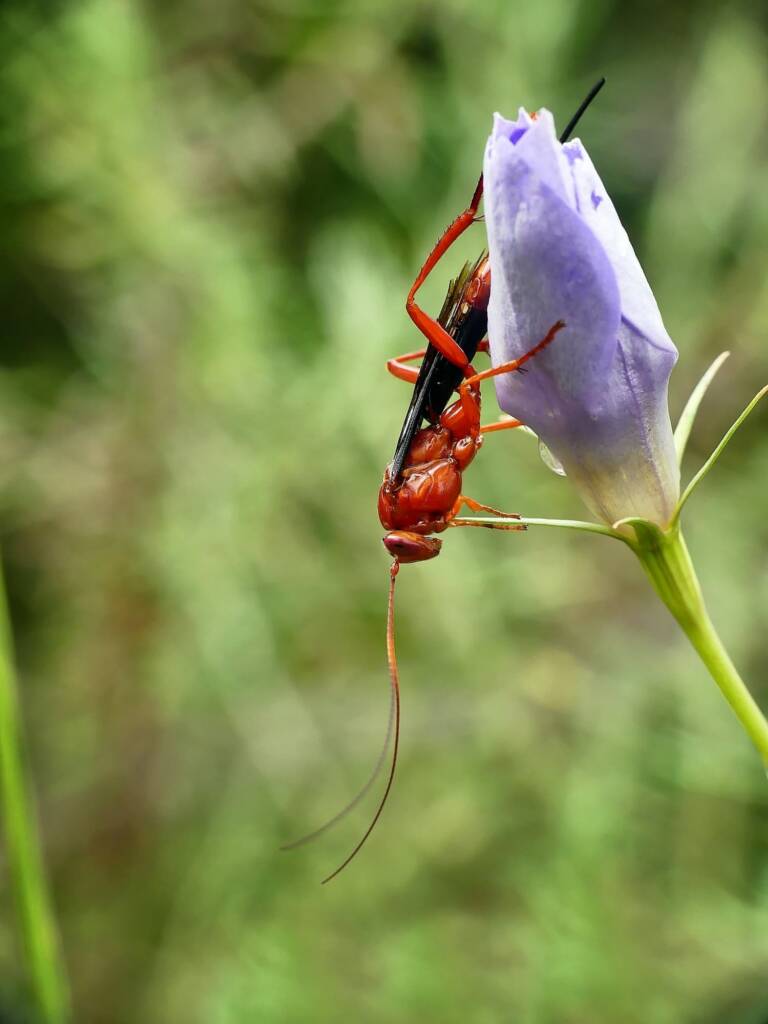
The head, mesosoma, legs and apical segments of the metasoma of the Orchid Dukpe Wasp are red-brown in colour, and the first four segment of the metasoma are black with large paired white spots. The wings of the wasp have a dark, smoky brown appearance, becoming lighter to transpart towards the tip of the wings.
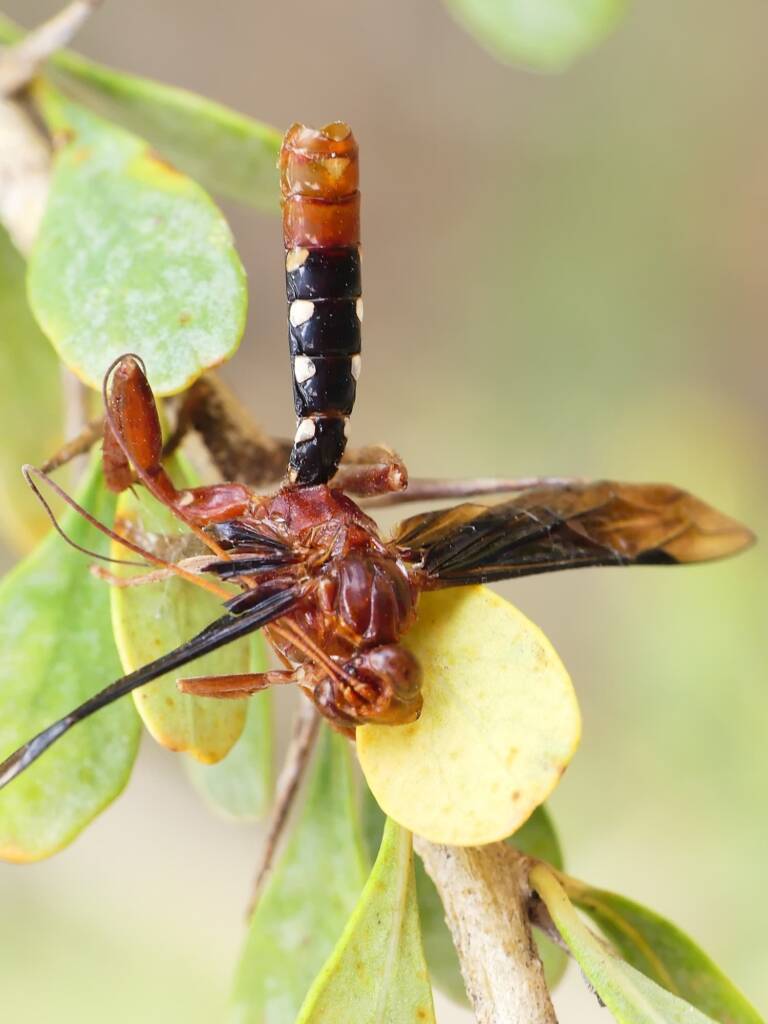
The wasp has long antennae and what looks like a “stinger”, which is actually an ovipositor (through which she lays her egg). When she finds her prey, she uses the ovipositor to inject an egg into the body of prey. The egg will hatch and consume the caterpillar from the inside out.
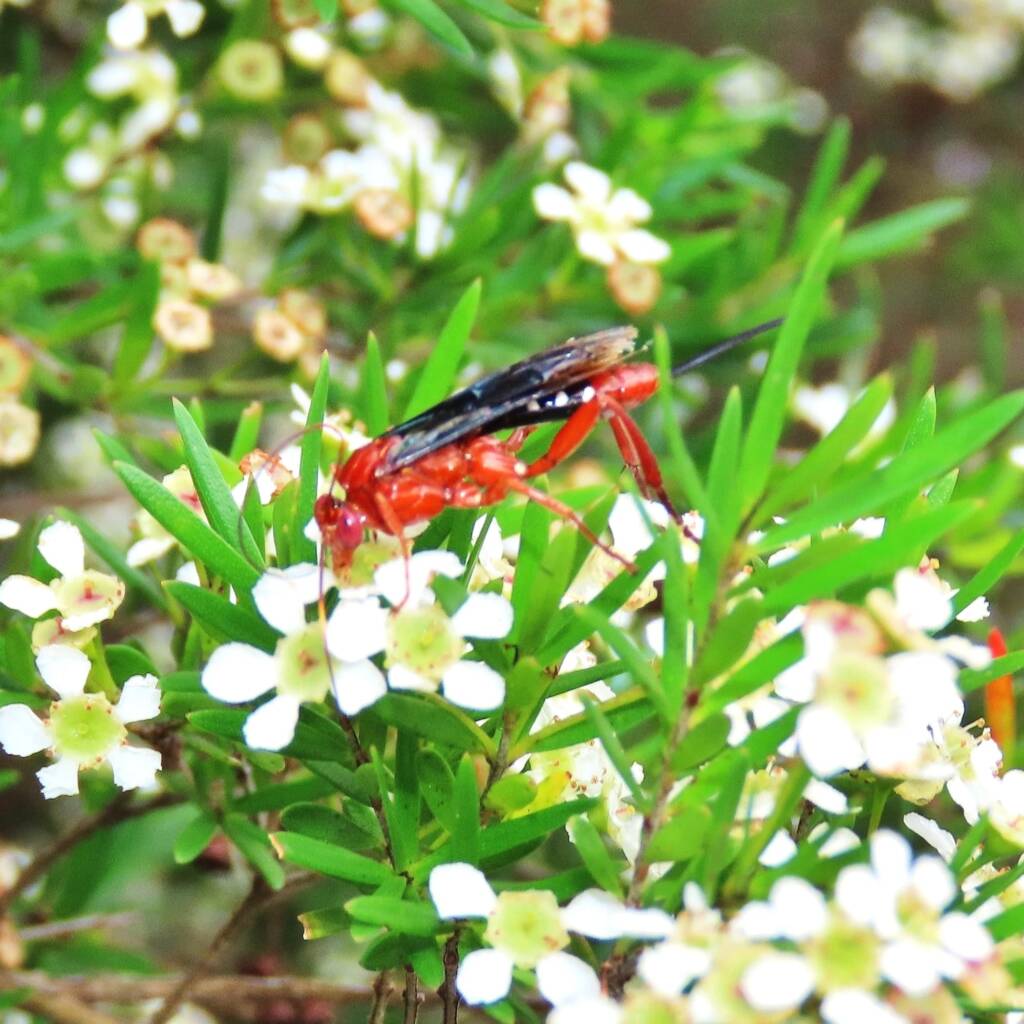
The common name of “Orchid Dupe Wasp” is in reference to the male of the species, whose role is to seek out the female and mate with her. The male wasp use their long, sensitive antennae to detect pheromones released by females, to find her. Certain native orchid species such as the Tongue Orchids (genus Cryptostylis), release matching scents to that of the female wasp pheromones, tricking the male into pollinating the orchids by carrying pollen from one orchid to another orchid. They are known to pollinate all Australian native orchid species of the genus Cryptostylis.
The term “pseudocopulation” describe the phenomenon of flowers that resemble the female wasp parts, which is also recorded in other orchid genera.
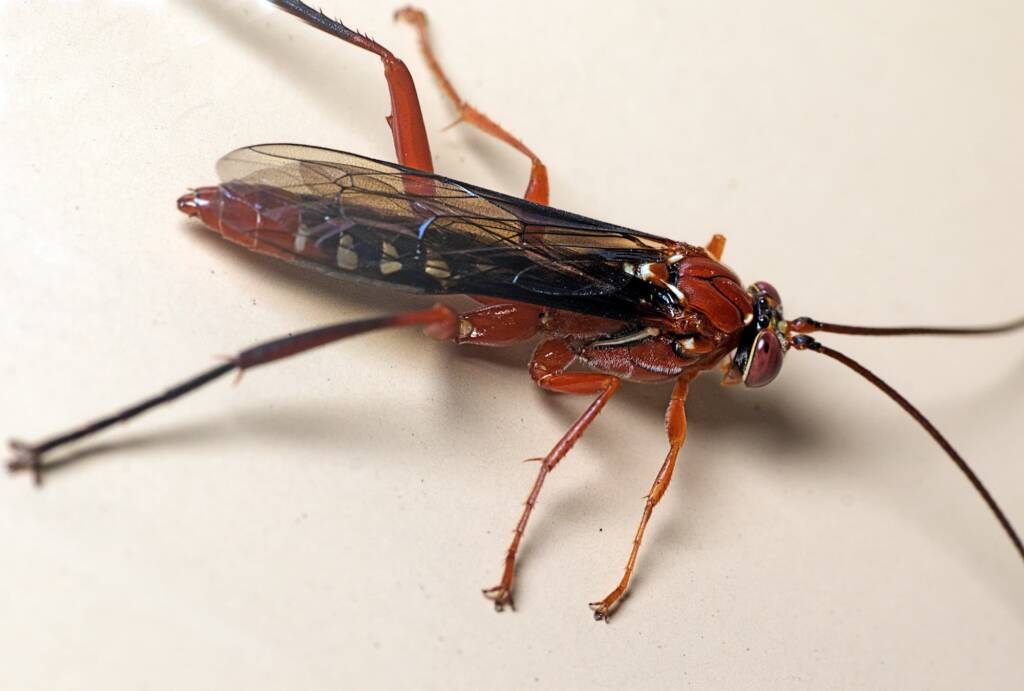
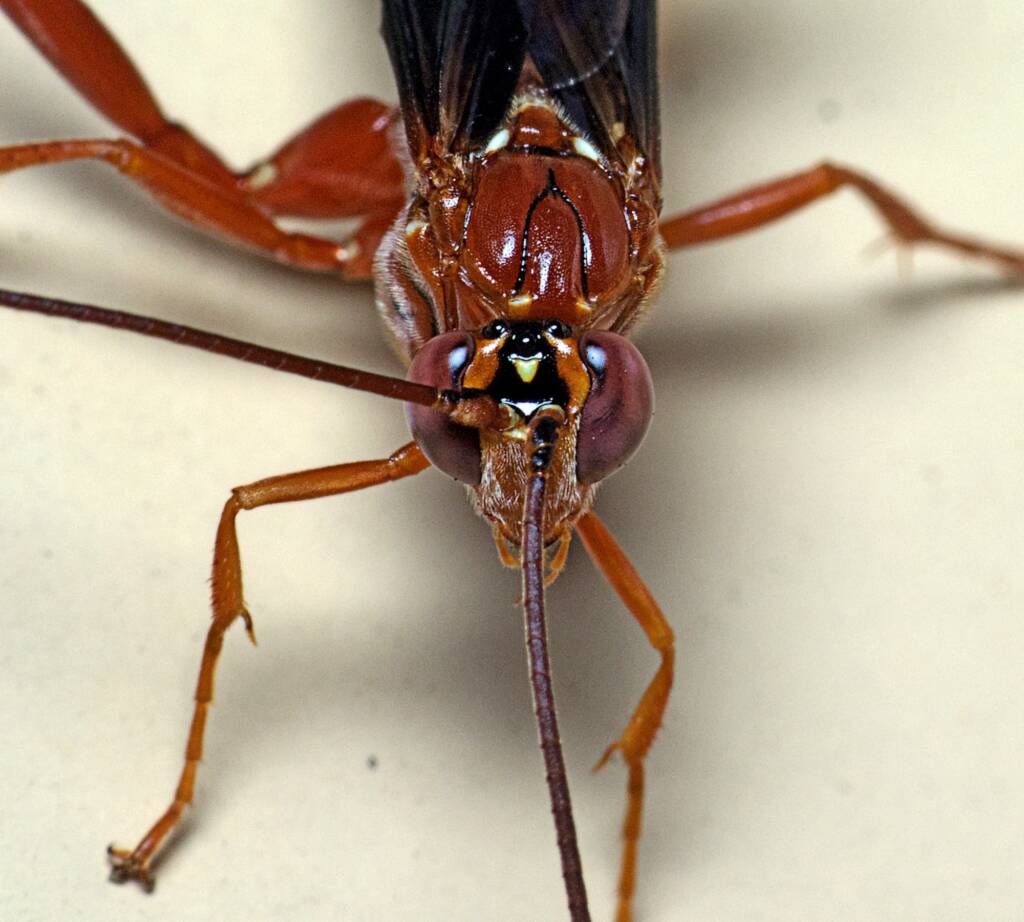
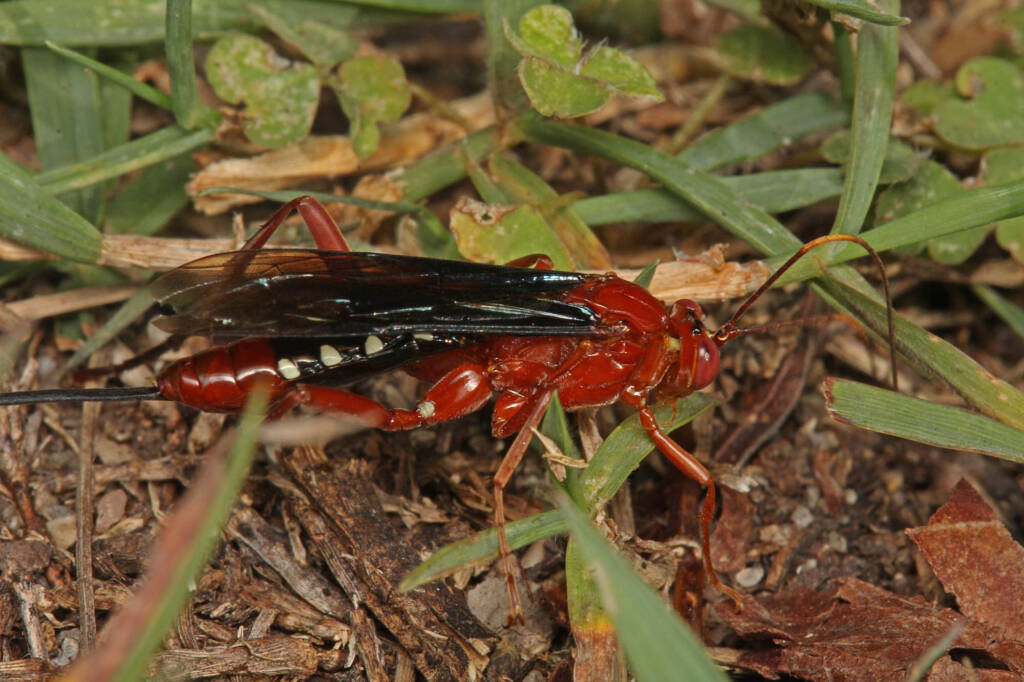
- Scientific classification
- Kingdom: Animalia
- Phylum: Arthropoda
- Subphylum: Hexapoda
- Class: Insecta
- Informal: Pterygotes
- Order: Hymenoptera
- Superfamily: Ichneumonoidea
- Family: Ichneumonidae
- Subfamily: Pimplinae
- Genus: Lissopimpla
- Species: Lissopimpla excelsa
Footnote & References
- Lissopimpla excelsa (Costa, 1864), Atlas of Living Australia, https://bie.ala.org.au/species/https://biodiversity.org.au/afd/taxa/9e602831-9ffb-4491-83bb-fafcf96fc3fe
WaspsWasps Index Australian Large Wasps Australian Mud Nest Wasps Mud Wasp Velvet Ants Abispa ephippium Acarozumia amaliae Aulacidae Australodynerus Bembix Bembicinae Blue Hairy Flower Wasp Braconidae Chrysididae Cryptocheilus bicolor (Orange Spider Wasp) Delta latreillei (Potter Wasp) Eumeninae Ferreola handschini (Orange-collared Spider Wasp) Flower Wasps Gasteruptiid Wasp Hairy Flower Wasps Isodontia (Grass-carrying Wasp) Lissopimpla excelsa (Orchid Dupe Wasp) Mutillidae Paralastor sp. Pseudabispa bicolor ssp. nigrocinctoides Radumeris radula (Yellow Hairy Flower Wasp) Radumeris tasmaniensis (Yellow Hairy Flower Wasp) Sceliphron laetum Thynnid Wasps Tiphiidae Yellow and Black Wasp
InsectsBees Beetles Blattodea Butterflies Coleoptera Cicada Crabronidae Diptera Dragonflies & Damselflies Formicidae Hemiptera Heteroptera (True Bugs) Mango Planthopper Moths Orthoptera Orthopteroid Processionary Caterpillar Stink Bugs, Shield Bugs and Allies Syrphidae Wasps Water Scorpion (Laccotrephes tristis) Witchetty Grub
